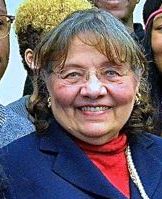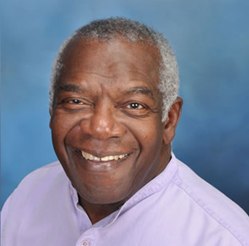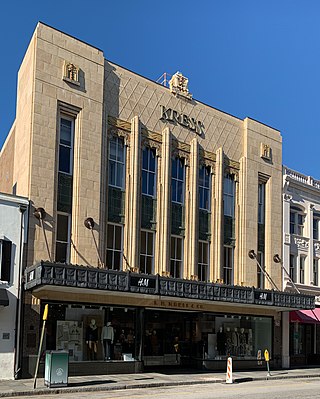Related Research Articles

James Morris Lawson Jr. is an American activist and university professor. He was a leading theoretician and tactician of nonviolence within the Civil Rights Movement. During the 1960s, he served as a mentor to the Nashville Student Movement and the Student Nonviolent Coordinating Committee. He was expelled from Vanderbilt University for his civil rights activism in 1960, and later served as a pastor in Los Angeles for 25 years.

A sit-in or sit-down is a form of direct action that involves one or more people occupying an area for a protest, often to promote political, social, or economic change. The protestors gather conspicuously in a space or building, refusing to move unless their demands are met. The often clearly visible demonstrations are intended to spread awareness among the public, or disrupt the goings-on of the protested organisation. Lunch counter sit-ins were a nonviolent form of protest used to oppose segregation during the civil rights movement, and often provoked heckling and violence from those opposed to their message.

Diane Judith Nash is an American civil rights activist, and a leader and strategist of the student wing of the Civil Rights Movement.

The Nashville sit-ins, which lasted from February 13 to May 10, 1960, were part of a protest to end racial segregation at lunch counters in downtown Nashville, Tennessee. The sit-in campaign, coordinated by the Nashville Student Movement and the Nashville Christian Leadership Council, was notable for its early success and its emphasis on disciplined nonviolence. It was part of a broader sit-in movement that spread across the southern United States in the wake of the Greensboro sit-ins in North Carolina.
Ernest Adolphus Finney Jr. was the first African-American Supreme Court Justice appointed to the South Carolina Supreme Court since the Reconstruction Era. He spent the last years of his life in Sumter, South Carolina. He was a member of Alpha Phi Alpha fraternity.
The Albany Movement was a desegregation and voters' rights coalition formed in Albany, Georgia, in November 1961. This movement was founded by local black leaders and ministers, as well as members of the Student Nonviolent Coordinating Committee (SNCC) and the National Association for the Advancement of Colored People (NAACP). The groups were assisted by Martin Luther King Jr. and the Southern Christian Leadership Conference (SCLC). It was meant to draw attention to the brutally enforced racial segregation practices in Southwest Georgia. However, many leaders in SNCC were fundamentally opposed to King and the SCLC's involvement. They felt that a more democratic approach aimed at long-term solutions was preferable for the area other than King's tendency towards short-term, authoritatively-run organizing.
Cleveland "Cleve" Sellers Jr. is an American educator and civil rights activist.

Ruby Doris Smith-Robinson worked with the Student Nonviolent Coordinating Committee (SNCC) from its earliest days in 1960 until her death in October 1967. She served the organization as an activist in the field and as an administrator in the Atlanta central office. She eventually succeeded James Forman as SNCC's executive secretary and was the only woman ever to serve in this capacity. She was well respected by her SNCC colleagues and others within the movement for her work ethic and dedication to those around her. SNCC Freedom Singer Matthew Jones recalled, "You could feel her power in SNCC on a daily basis". Jack Minnis, director of SNCC's opposition research unit, insisted that people could not fool her. Over the course of her life, she served 100 days in prison for the movement.

The Freedom Singers originated as a quartet formed in 1962 at Albany State College in Albany, Georgia. After folk singer Pete Seeger witnessed the power of their congregational-style of singing, which fused black Baptist a cappella church singing with popular music at the time, as well as protest songs and chants. Churches were considered to be safe spaces, acting as a shelter from the racism of the outside world. As a result, churches paved the way for the creation of the freedom song. After witnessing the influence of freedom songs, Seeger suggested The Freedom Singers as a touring group to the SNCC executive secretary James Forman as a way to fuel future campaigns. Intrinsically connected, their performances drew aid and support to the Student Nonviolent Coordinating Committee (SNCC) during the emerging civil rights movement. As a result, communal song became essential to empowering and educating audiences about civil rights issues and a powerful social weapon of influence in the fight against Jim Crow segregation. Their most notable song “We Shall Not Be Moved” translated from the original Freedom Singers to the second generation of Freedom Singers, and finally to the Freedom Voices, made up of field secretaries from SNCC. "We Shall Not Be Moved" is considered by many to be the "face" of the Civil Rights movement. Rutha Mae Harris, a former freedom singer, speculated that without the music force of broad communal singing, the civil rights movement may not have resonated beyond of the struggles of the Jim Crow South. Since the Freedom Singers were so successful, a second group was created called the Freedom Voices.

Charles Melvin Sherrod was an American minister and civil rights activist. During the civil rights movement, Sherrod helped found the Albany Movement while serving as field secretary for southwest Georgia for the Student Nonviolent Coordinating Committee. He also participated in the Selma Voting Rights Movement and in many other campaigns of the civil rights movement of that era.
The Atlanta Student Movement was formed in February 1960 in Atlanta by students of the campuses Atlanta University Center (AUC). It was led by the Committee on the Appeal for Human Rights (COAHR) and was part of the Civil Rights Movement.

Charles "Chuck" McDew was an American lifelong activist for racial equality and a former activist of the Civil Rights Movement. After attending South Carolina State University, he became the chairman of the Student Nonviolent Coordinating Committee (SNCC) from 1960 to 1963. His involvement in the movement earned McDew the title, "black by birth, a Jew by choice and a revolutionary by necessity" stated by fellow SNCC activist Bob Moses.
This is a timeline of the civil rights movement in the United States, a nonviolent mid-20th century freedom movement to gain legal equality and the enforcement of constitutional rights for people of color. The goals of the movement included securing equal protection under the law, ending legally institutionalized racial discrimination, and gaining equal access to public facilities, education reform, fair housing, and the ability to vote.

The Tougaloo Nine were a group of African-American students at Tougaloo College, who participated in civil disobedience by staging sit-ins of segregated public institutions in Mississippi in 1961.

The sit-in movement, sit-in campaign, or student sit-in movement, was a wave of sit-ins that followed the Greensboro sit-ins on February 1, 1960, led by students at North Carolina Agricultural and Technical Institute (A&T). The sit-in movement employed the tactic of nonviolent direct action and was a pivotal event during the Civil Rights Movement.
Joseph Charles Jones was an American civil rights leader, attorney, co-founder of the Student Nonviolent Coordinating Committee (SNCC), and chairperson of the SNCC's direct action committee.
Prior to the civil rights movement in South Carolina, African Americans in the state had very few political rights. South Carolina briefly had a majority-black government during the Reconstruction era after the Civil War, but with the 1876 inauguration of Governor Wade Hampton III, a Democrat who supported the disenfranchisement of blacks, African Americans in South Carolina struggled to exercise their rights. Poll taxes, literacy tests, and intimidation kept African Americans from voting, and it was virtually impossible for someone to challenge the Democratic Party, which ran unopposed in most state elections for decades. By 1940, the voter registration provisions written into the 1895 constitution effectively limited African-American voters to 3,000—only 0.8 percent of those of voting age in the state.

The Charleston sit-ins were a series of peaceful protests during the sit-in movement of the civil rights movement of the 1960s in Charleston, South Carolina. Unlike at other sit-ins in the South where the protestors were mainly college students, the protestors in Charleston were mainly high school students. The earliest such protest was a sit-in at a lunch counter by Charleston high school students, but similar protests continued thereafter.
The Atlanta sit-ins were a series of sit-ins that took place in Atlanta, Georgia, United States. Occurring during the sit-in movement of the larger civil rights movement, the sit-ins were organized by the Committee on Appeal for Human Rights, which consisted of students from the Atlanta University Center. The sit-ins were inspired by the Greensboro sit-ins, which had started a month earlier in Greensboro, North Carolina with the goal of desegregating the lunch counters in the city. The Atlanta protests lasted for almost a year before an agreement was made to desegregate the lunch counters in the city.
Reverend Cecil Augustus Ivory was a Presbyterian minister, disability rights activist and sit-in leader during the Civil rights movement.
References
- ↑ "The Friendship Nine / January 31, 1961". Herald Online. February 22, 2004. Retrieved December 1, 2010.
They were students at Friendship College and called themselves the Friendship Nine. The members of this group were James Wells, William "Dub" Massey, Robert McCullough, John Gaines, William "Scoop" Williamson, Willie McLeod, Thomas Gaither, Clarence Graham, Charles Taylor and Mack Workman.
[ permanent dead link ] - ↑ "Associated Press'Sing-In' Negroes Eat Hearty; Say 'Jail—No Bail'". The Spartanburg Herald. Associated Press. February 21, 1961. Retrieved December 1, 2010.
Eight Negro Demonstrators is a disciplinary cell at the York County Prison Camp accepted and ate second helpings Monday of the full meal given every third day to prisoners on bread and water.
- ↑ Scoggins, Michael, Rawlinson David. "Rock Hill, Jail No Bail & The Friendship Nine". Friendship Jr. College 445 Allen St. Rock Hill, South Carolina. Archived from the original on 17 November 2011. Retrieved 21 October 2011.
{{cite web}}: CS1 maint: multiple names: authors list (link)"(..) The first man tried was Charles Taylor, the Friendship student from New Jersey. Taylor was tried, found guilty, convicted, and sentenced to $100 fine or 30 days hard labor on the York County Prison Farm. The protesters' attorney, an African-American lawyer from Sumter named Ernest A. Finney, then asked the judge to let Taylor's trial be used as a basis for the other nine and the judge agreed. The other nine were then tried, found guilty, and sentenced to the same punishment. Taylor was concerned about possibly losing his athletic scholarship at Friendship, so with the assistance of the NAACP, he paid his bail and was released. The NAACP offered to pay the bail for the remaining nine protesters but they refused, and on February 2, they began serving out their 30-day sentences on the county prison farm. After beginning their sentence on the county farm, the nine protesters were quickly given the appellation "Friendship Nine" by the press, and the case became famous nationwide. Motorcades of other protesters and supporters converged on the prison, and members of the Student Nonviolent Coordinating Committee (SNCC) came to Rock Hill and demonstrated; they too were arrested, jailed and refused bail. Over the course of the next year further demonstrations and arrests followed in Rock Hill, as well as in other cities throughout the United States. Protesters across the country adopted the "jail no bail" policy implemented by the Friendship Nine, and served out their jail sentences rather than helping to subsidize a system that supported segregation and inequality. These acts of heroism by the Friendship Nine and others helped to spur even larger protests like the March on Washington for Jobs and Freedom in August 1963 and the famous march from Selma to Montgomery in March 1965. (..)" - ↑ "Jail, No Bail' Idea Stymied Cities' Profiting From Civil Rights Protesters". South Carolina ETV's "Carolina Stories.". The PBS NewsHour. Archived from the original on 10 March 2011. Retrieved 21 October 2011."The 'Jail, No Bail' strategy became a new tactic in the fight for civil rights. Documentary produced by South Carolina ETV documenting the key moment in civil rights history." (Video and Audio)
- ↑ "Jail, No Bail". Carolina Stories. South Carolina ETV. Archived from the original on 19 December 2011. Retrieved 21 October 2011."(..) In previous sit-ins across the South, protestors were arrested, processed by the police, fined and then released, creating a dubious revenue stream from which many municipalities easily profited. But when the Friendship students went before the judge, they chose to serve their time behind bars. For the first time, not only did the city not collect its $100 per person, it actually had to pay to house and feed the men. (..) Word of their action spread like wildfire, receiving national media attention, including the New York Times. The "Jail, No Bail" strategy became the new tactic that helped galvanize the civil rights protest movement. (..)"
- ↑ Hartford, Bruce. "Rock Hill SC, "Jail-No-Bail" Sit-ins (Feb-Mar)". The Civil Rights Movement Archive. Westwind Writers Inc. Retrieved 21 October 2011."(..) At the October 1960 SNCC strategy conference in Atlanta, some activists argue for "Jail-No-Bail" tactics. They take a Gandhian position that paying bail or fines indicates acceptance of an immoral system and validates their own arrests. And by serving their sentences, they dramatize the injustice, intensify the struggle, and gain additional media coverage. There is also a practical component to "Jail-No-Bail." The Movement has little money and most southern Blacks are poor. It is hard to scrape up bail money, and sit-in struggles are faltering — not from lack of volunteers to risk arrest — but from lack of money to bail them out. Moreover, paying fines provides the cops with financial resources that are then used to continue suppressing the freedom struggle. By refusing bail, they render meaningless the no-money-for-bail barrier and by serving time they put financial pressure on local authorities who have to pay the costs of incarcerating them. (..)"
- ↑ Lauren Hoyt / The Herald (February 2, 2003). "Activists revive memories of '60s sit-in". Herald Online. Retrieved December 1, 2010.
The three men each vividly recounted Jan 31 1961 when they were arrested for a siting at Rock Hill's McCrory's department store and the ensuing 30 days ...
[ permanent dead link ] - ↑ "Negroes Open New Front". St. Petersburg Independent. Associated Press. February 9, 1961. Retrieved December 1, 2010.
In Rock Hill, SC, 150 Negroes and a white man staged a mass protest against segregation.
- ↑ "Sumpter Sit-in Case Up". The Sumter Daily. Associated Press. November 12, 1962. Retrieved December 1, 2010.
The first case on the court's agenda involved 65 students from Friendship Junior College at Rock Hill. They were arrested March 15, 1960 for demonstrating in front of the Rock Hill city hall.
- ↑ "Rock Hill Negro Convicted on Sit-in Charges". The News and Courier. July 15, 1960. Retrieved December 1, 2010.
Arthur Hamm, recent graduate of Friendship College here, and a demonstration leader, did not appear in city court….Hamm was arrested with the Rev. A.C. Ivory….
[ permanent dead link ] - ↑ "8 Jailed Negroes Put In Solitary; Refuse To Work". The Free Lance-Star. February 20, 1961. Retrieved December 1, 2010.
Eight Negro students jailed in a Rock Hill, S. C. sit-in demonstration have been placed on bread and water in solitary confinement for what prison officials called a refusal to work.
- ↑ McGuire, Justin (January 27, 2007). "Historic marker unveiled by Friendship Nine". Herald Online. Archived from the original on September 27, 2007. Retrieved December 2, 2010.
- ↑ Dys, Andrew. "Rock Hill civil rights icon tells young people: 'Be great'". The Rock Hill, SC Herald. The McClatchy Co. Archived from the original on 20 October 2013. Retrieved 15 October 2013.
- ↑ "'An American hero.' Friendship 9 member and Rock Hill civil rights icon dies". heraldonline. Retrieved 2018-07-14.
- ↑ https://www.robinsonfuneralhomerh.com/obituary/mack-workman
- ↑ Weiss, Mitch (January 2015). "Famed SC civil rights protesters have convictions erased". WJTV News. Associated Press. Archived from the original on 2015-01-30. Retrieved 2015-01-28.
- ↑ Payne, Amber (January 28, 2015). "'Friendship Nine': Convictions Overturned For Famed Civil Rights Protesters". NBC News. Associated Press. Retrieved 2015-01-28.